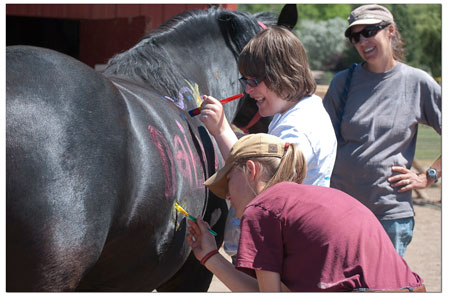 |
|
Medicine Horse instructor Alison Taylor, left, and student Savannah Gwillian concentrate on giving Daisy, the horse, some new markings while volunteer Becca Smith looks on during Medicine Horse’s autism camp held earlier this month. The camp strives to help people with autism and other sensory disabilities make emotional connections./Photo by Ginny Getts
|
Making strides
Horse camp helps kids with autism break through
The Medicine Horse Story
by Malia Durbano
As rates for autism and related disorders skyrocket, with an estimated one in 88 children afflicted, one local nonprofit is taking the reins on breaking through the invisible bubble in which many autistic children live.
by Malia Durbano
As rates for autism and related disorders skyrocket, with an estimated one in 88 children afflicted, one local nonprofit is taking the reins on breaking through the invisible bubble in which many autistic children live.
For the last few years, the Mancos-based Medicine Horse Center, which offers a full slate of therapy programs, has been using horses to make contact with kids where other methods have failed. Geared toward ages 5 - 12, the week long summer camp, which took place June 10-15, includes therapeutic riding, sensory integration games, fine and gross motor skills development, social skills development and horse-themed arts and crafts.
According to Medicine Horse Program Director Trish Lemke, the horses help people suffering from with autism spectrum or associated sensory processing disorders come out of their own worlds and learn to connect to others and experience positive social interactions.
“Results are achieved far more quickly using the horses,” explains Lemke of the overall equine-therapy model. “What could take years in talk therapy can often be accomplished in weeks of equine assisted therapy. It is a great complement to talk therapy.”
As a Certified Equine Interaction Professional, Lemke also works with a licensed therapist at the camp. Furthermore, all Medicine Horse camp staff are certified through PATH, the Professional Association for Therapeutic Horsemanship, to ensure as good an experience as possible for participants. Camps are kept small so participants get the one-on-one attention they need.
“This Autism Spectrum Camp concentrates on the issues unique to this population,” said Executive Director Lynne Howarth. “The biggest factor is that the horse truly reaches a person at a core level. Horses are conduits for making change because the horses are open. A connection is made and students develop a relationship with the horse.”
Working with horses can help build a foundation for trust, as horses only approach people they feel safe around. “It’s how they’ve survived for centuries,” said Horwath.
Correspondingly, the child experiences feelings of acceptance and love – feelings that are not always easy to tap into.
In addition to the psychological connection, the horses provide the vehicle, literally and figuratively, to work on body awareness and being focused and calm. Lemke elaborates, “Individuals coping with autism spectrum disorder issues have brains that are always trying to sort things out. Focusing on being on the horse provides a sense of peace and allows them to just be.”
Every student has a side-walker and a horse leader, so students feel safe. Group dynamics enable the staff to work on social skills such as waiting, listening and taking turns. “Being on a horse makes them focus on what they’re doing, and allows them to take a break from self-stimulating behaviors” said Lemke. “Sometimes the students have issue with noise or wearing helmets. It’s good for them to work through these issues.”
Lemke said successes children have overcoming issues with the horses often transfer to other areas of their lives. “We had one young girl who compulsively had to wash her hands all the time. Every few minutes, she’d be running to wash her hands,” said Lemke. “Then, by brushing, feeding and working with the horses, she got distracted and forgot all about it. Carrying that behavior over into other areas of her life has been a great gift.”
Furthermore, simple social skills like waiting your turn and listening are accomplished more easily utilizing horses. “We had a little girl who was acting out and hitting her mother. Conversely, she was calm, sweet and gentle with the horse,” said Lemke. “We used this opportunity to talk with her about empathy and how her actions are affecting the horse and her mother.”
Other activities at the camp address fine and gross motor skills that improve by brushing the horses and engaging in crafts. Participants actually paint and stencil right on the horses with water-based paint. Attention span is increased as they are encouraged to finish their drawings. Meanwhile, other senses are engaged by playing with balls and water games, going on nature walks and scavenger hunts.
But by far, the greatest strides are made with the horses themselves. “The privilege of being on a horse is a great incentive,” said Lemke.
Lead Therapeutic Riding Instructor Allison Taylor shared a story from this year’s camp of a 9-year-old riding for the first time. The girl started out timid as she began to work on different skills such as being relaxed and using voice commands, her legs, the reins and language to control the horse. On the third day, Taylor told the girl if she showed she’d learned the skills, the next day, she would let her ride alone.
“I could tell she really thought about it and was concentrating,” said Taylor. “By the end of the session she rode the obstacle course perfectly! She was so excited, she came out of her shell and gave me a high five and a big hug!”
In this week's issue...
- May 15, 2025
- End of the trail
Despite tariff pause, Colorado bike company can’t hang on through supply chain chaos
- May 8, 2025
- Shared pain
Dismal trend highlights need to cut usage in Upper Basin, too
- April 24, 2025
- A tale of two bills
Nuclear gets all the hype, but optimizing infrastructure will have bigger impact
